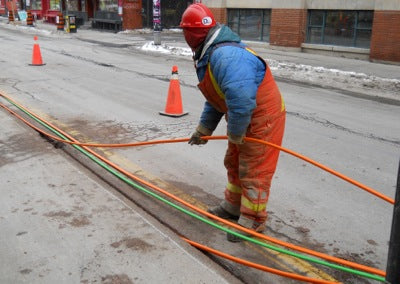Introduction to Micro Trenching: Definition and Purpose
Micro trenching has emerged as a popular technique in the field of telecommunications and underground utility installations. With its ability to provide efficient and cost-effective solutions, micro trenching has gained significant attention from industry professionals. In this blog post, we will delve into the definition and purpose of micro trenching, exploring its key features, advantages, and applications.
**What is Micro Trenching?**
Micro trenching refers to the process of creating narrow and shallow trenches in the ground, typically ranging from 0.5 to 2 inches in width and 6 to 12 inches in depth. These trenches are usually made using specialized equipment such as micro trenching machines. The primary purpose of micro trenching is to install various underground utilities, including fiber optic cables, conduits, and other telecommunications infrastructure.
Unlike traditional trenching methods that require large, disruptive excavations, micro trenching offers a less invasive and more precise alternative. It enables the installation of underground infrastructure in densely populated areas, narrow streets, and urban environments where space is limited or where the disruption caused by traditional trenching would be impractical.
**The Purpose of Micro Trenching**
Micro trenching serves several purposes, each contributing to its growing popularity and adoption in various industries. Let's explore some of the key purposes and benefits of micro trenching:
1. **Efficient Installation:** Micro trenching allows for faster and more efficient installation of underground utilities. The narrow and shallow trenches can be created quickly, reducing the time required for excavation and restoration.
2. **Cost-Effective Solution:** Micro trenching offers significant cost savings compared to traditional trenching methods. The reduced excavation size minimizes material and labor costs, making it an attractive option for projects with budget constraints.
3. **Minimal Disruption:** Micro trenching causes minimal disruption to the surrounding environment. The narrow trenches require less space, reducing the impact on pedestrians, traffic flow, and existing infrastructure. This makes micro trenching ideal for urban areas and locations with limited access.
4. **Precision and Accuracy:** The use of specialized micro trenching equipment ensures precise and accurate trench dimensions. This level of precision allows for efficient installation of underground utilities and reduces the risk of damage to existing infrastructure.
5. **Versatility in Applications:** Micro trenching is widely applicable in various industries. It is commonly used in telecommunications for fiber optic network installations, but it can also be employed for other utilities such as electrical conduits, water pipes, and gas lines.
6. **Sustainable and Environmentally Friendly:** Micro trenching promotes sustainability by minimizing the environmental impact. The smaller trenches require less excavation and generate less waste, reducing the carbon footprint associated with the installation process.
7. **Future-Proof Infrastructure:** Micro trenching provides flexibility for future upgrades and expansions. The narrow trenches can accommodate additional cables or conduits, allowing for easy integration of new technologies without the need for extensive excavation.
**Applications of Micro Trenching**
Micro trenching finds applications in various sectors, primarily in the telecommunications industry. Here are some notable applications of micro trenching:
1. **Fiber Optic Networks:** Micro trenching is widely used for installing fiber optic cables, enabling high-speed internet connectivity and supporting the increasing demand for data transmission.
2. **Smart City Infrastructure:** Micro trenching plays a crucial role in the development of smart cities. It facilitates the installation of communication networks, sensor systems, and other smart city components.
3. **Utility Installations:** Micro trenching is employed for the installation of electrical conduits, water pipes, and gas lines, providing efficient and precise underground utility infrastructure.
4. **Renewable Energy:** Micro trenching is utilized in the installation of underground cables for renewable energy projects, such as solar farms and wind turbines, enabling the efficient transmission of power.
**Conclusion**
Micro trenching has revolutionized the installation of underground utilities, offering a more efficient, cost-effective, and environmentally friendly alternative to traditional trenching methods. With its narrow and shallow trenches, micro trenching provides precise and accurate installations while minimizing disruption to the surrounding environment. Its applications in telecommunications, smart city infrastructure, and utility installations make micro trenching a versatile solution for various industries. As technology continues to advance, micro trenching is expected to play an increasingly significant role in shaping our future infrastructure.
Remember, this blog post provides a brief introduction to micro trenching, touching upon its definition, purpose, and applications. To gain a deeper understanding of micro trenching and its implementation, further research and exploration of case studies and best practices are highly recommended.
Should you have any further questions or require more information, feel free to reach out to info@sewergearguru.com

